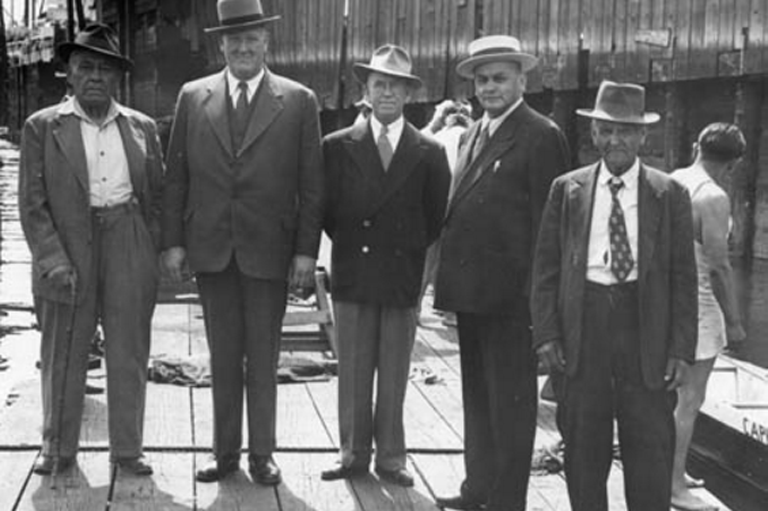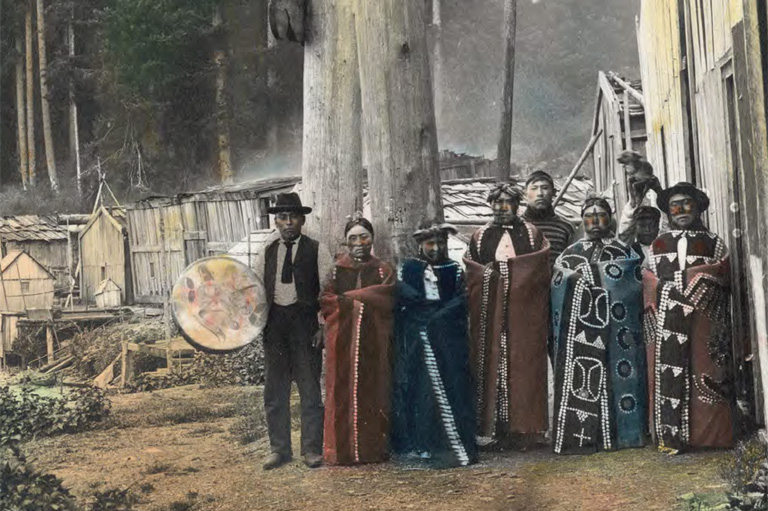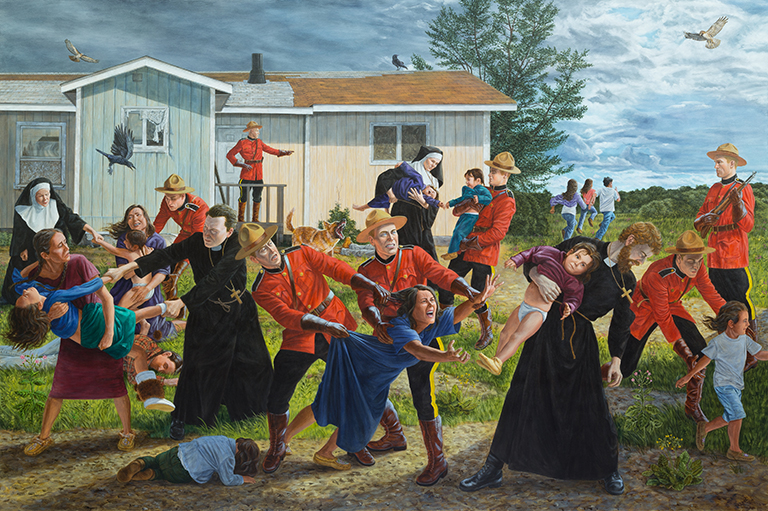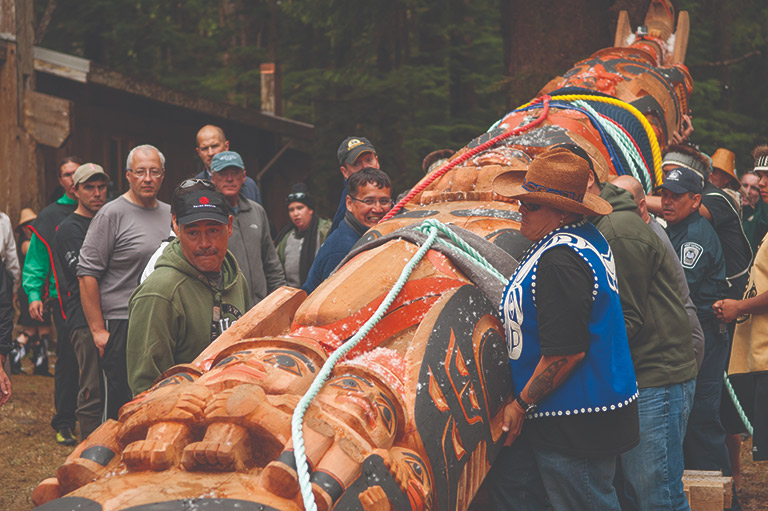Discover a wealth of interesting, entertaining and informative stories in each issue, delivered to you six times per year.
A Community's Loss
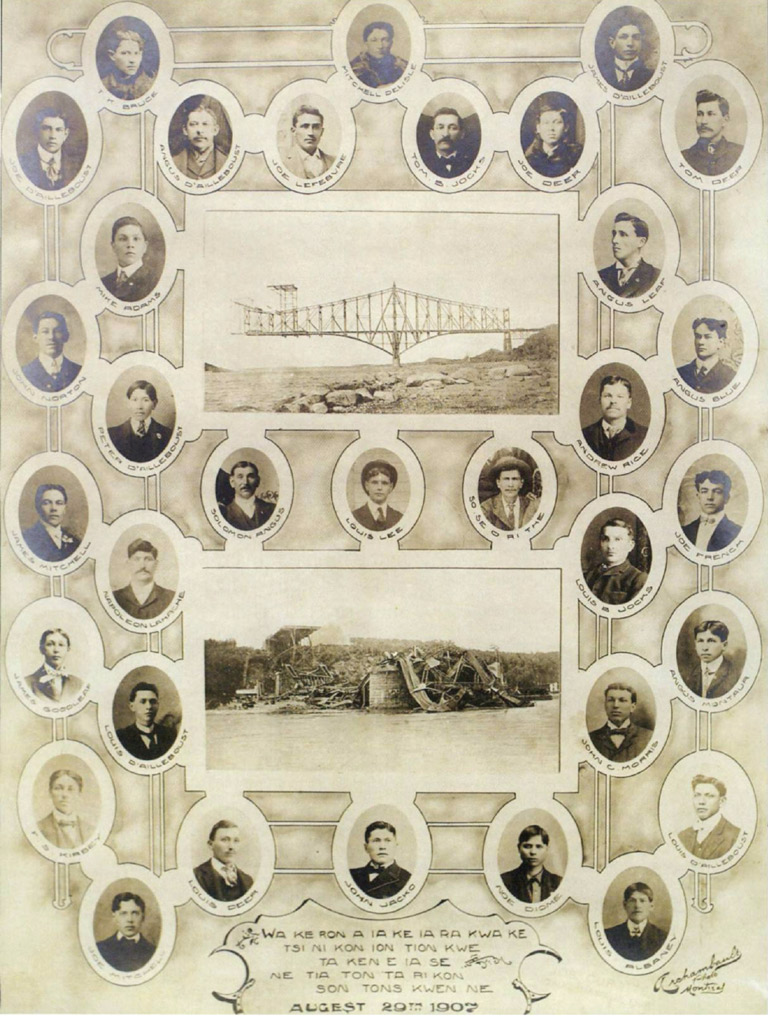
Shontoskwenne is what the Mohawks of Kahnawake call the Quebec City bridge disaster. It’s pronounced “soon-doe -SKWONN-nay,” and means “when the bridge fell.”
When the bridge fell, the Mohawks lost 33 of their men. Gone in an instant were breadwinners for 22 families, most of them in their 20s or 30s.
When the bridge fell, suddenly 25 women were widows, 53 children were fatherless. No other community was hit as hard.
When the bridge fell, the D’Aillaboust family suffered the biggest loss — four brothers, an uncle, a cousin and a brother-in-law all died, leaving 22 children without fathers. Ten of those were in the household of Joseph Orite D’Aillaboust, whose widow was pregnant with their 11th child.
When the bridge fell, it was also a major blow to Kahnawake’s increased economic reliance on high-steel construction, for which its workers had gained widespread acclaim.
“It is the most major event in our history;” says band elder Andrew Delisle Sr. He was chief of Kahnawake from 1963 to 1970 and 1974 to 1981, and in 1969 became the first Indigenous person to receive the Order of Canada. His uncle Mitchell Delisle, at 25, was a victim of shontoskwenne.
Delisle says Kahnawake “never has talked about it,” not because it was too painful to remember, but because “it was accepted right away” as part of Kahnawake’s proud tradition of bravery and independence.
“Young people wanted to emulate their forefathers’ bravery as voyageurs, warriors [helping the English capture Montreal without bloodshed in the Seven Years’ War] and rafters over the Lachine Rapids. Thus, they weren’t hesitant about the dangers of bridge-building. Their training as “rivet punks” began at age 12; they started by fetching equipment.
Riveting gangs enjoyed competing against one another to determine which would finish their riveting job first. Then “reservation Indians,” they never wanted to be dependent on the government, but rather to be self-sufficient. While permission was needed from the government’s Indian Agent to work off the reservation for most jobs, it was not [needed] for bridge-building, because of our skill.”

Kahnawake, its population then just over 2,000, was a close-knit community of extended families.
“Not every family had victims but everyone felt some loss because they knew a name or were neighbours,” says Billy Two Rivers, a council member from 1978 to 1998 and an organizer of a centennial commemoration to be held in 2007.
“It had a long-term impact on the family structure, creating an imbalance between men and women. It was a tremendous number of men to lose.”
Kahnawake, meaning “at the rapids,” is 10 kilometres southwest of Montreal.
Mohawks converted to Catholicism by French Jesuits established it in 1716. Until 1980, when Kahnawake was recognized as the official name, outsiders called it “Caughnawaga,” the way early Dutch settlers in America adjusted it to their language.
The phonetic English pronunciation is Guh-na-WA-geh. The chief sources of income were the fur trade, logging, farming, crafts (moccasins, snowshoes, beadwork) and river piloting, until the men got into bridge construction by chance.
In the 1850s the construction process fascinated river pilots who were delivering stone from Kahnawake’s quarries to the site of Montreal’s Victoria Bridge. Fearlessly, they clambered along the high support beams in their moccasins for a close-up view. Those in charge of the work were impressed. Until then it had been customary to hire sailors comfortable with heights. Easily trained, the Kahnawakehronon were quickly in demand, especially as riveters, the most dangerous high-steel job.
“They were as agile as goats … immune to the noise of riveting which usually makes newcomers to construction sick and dizzy,” a Dominion Bridge Company official was quoted in a 1949 New Yorker story about Indigenous skyscraper builders. “Putting riveting tools in their hands was like putting ham with eggs.” By 1907, there were 70 Kahnawake bridge workers, almost half toiling on the Quebec Bridge.
The village learned of the disaster when its only phone rang in the post office at 6:30 p.m., 53 minutes after the bridge collapsed. Postmaster Antoine Glasson ran into the street with the devastating news. Desperate for information, 30 villagers went to the accident site the next morning.
“The poor old mother and two of the wives were there first thing this morning to find out if there was any hope,” the Toronto Star wrote of the D’Aillabousts. “Their quiet intense grief was most touching and brought tears to the eyes of onlookers even more than if it had been voiced. The poor things simply sat quiet in the office hardly uttering a word, but the mere look of their faces was enough to cause strong ones to lower their voices to whispers.”
Only eight Mohawk bodies were recovered. They were taken by train from Quebec City to Montreal, then transported to Kahnawake. Since the community only had two hearses, it borrowed four from neighbouring communities; the remaining two coffins were carried to St. Francis Xavier Church at Kahnawake for a Catholic mass followed by an Indigenous death chant. An overflow crowd of hundreds prayed outside the church.
Only 16 bodies [in total] were pulled out of the rubble with crowbars and tackle. All were badly mutilated, some severed in half.
When the disaster occurred, the daughters of two of the victims were in their second week at a government-sponsored, missionary-run residential English school on Ontario’s Manitoulin Island, in Georgian Bay, 330 kilometres north of Toronto. Their fathers had wanted them to be trilingual.
One of them, Satekenhatie, in 1997 a 102-year-old elder whose English name is Marion Patten Phillips, recalled the time in an interview for Kahnawake’s Elders’ Calendar.
“There were several girls from Kahnawake at the school. Being together made us happy. We were all heartbroken by the tragedy and all wept together. None of the girls returned home because the distance was too far.”

Six Indigenous workers survived the disaster. Alexander Beauvais, team leader of a riveting “four gang,” had a particularly amazing escape. Half an hour before the collapse he had reported to C.R. Meredith, the rivet boss, two rivets had broken off near a splice, and ribs were bending. Meredith replied that he did “not think it serious.”
Driving rivets inside a chord (part of the framework) when the bridge began falling, Beauvais could neither see nor hear what was happening. When he felt the break, he wrapped his arms and legs around the chord. Beauvais escaped being crushed because the chord landed erect.
Everything happened so quickly he didn't realize one foot and his nose had broken. Two of his rivet teammates perished; the other was off due to a leg injury. Meredith, 26, died.
Beauvais returned to construction, becoming a Dominion Bridge Company superintendent. The company supplied him with steel to erect a six-metre memorial cross at each end of Kahnawake and donated money for him to build a memorial steel portico in the cemetery where his workmates were interred.
Fifteen days’ due wages were paid to the families of the dead and to injured survivors, with one bizarre complication. “A question arose in one case in which a man seemed to have committed bigamy and uncertainty arose as to who was the proper recipient of the money,” James Macrae, inspector of Indian Agencies and Reserves, reported in a Department of Indian Affairs memorandum.
Macrae advised Kahnawake’s band council to financially help only “widows and orphans in real need,” otherwise claims for damages against the Phoenix Bridge Company “might be affected.” He also advised against sending the victims’ children to government-run industrial schools (usually small, with one teacher for several grades) “because it could be construed by the company as a mitigation of damages.”
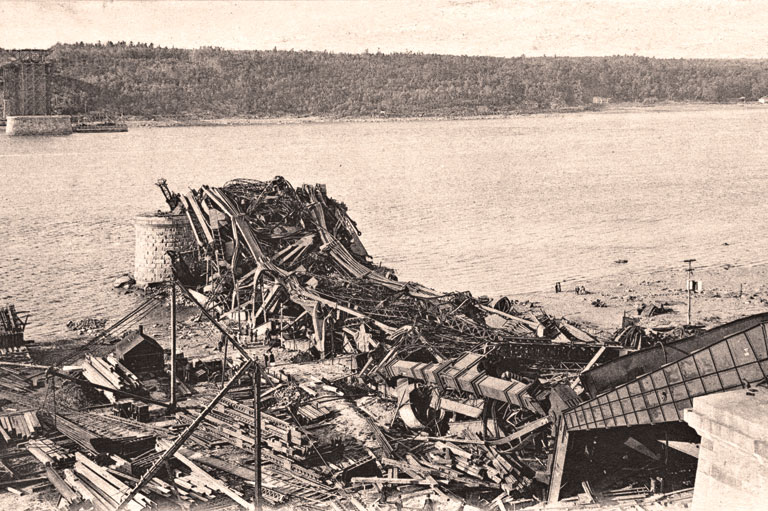

In September 1908, Macrae, as guardian, accepted a $100,000 lump sum for the minor children of the victims from the Phoenix Bridge Company.
In poignant December 1910 correspondence to the Indian Affairs department, lawyers for victim Thomas Deer’s young widow pleaded for speedy payment of her 3-year-old son George’s $300 allowance. She had tuberculosis, didn’t expect to live through the winter and wanted assurance her son would get the money.
In 1912, George’s grandparents applied for $300 to build a house for themselves, saying it would be the boy’s property. The department refused, stating the boy “is and will be away for some years attending school.”
The compensation issue came up again in 1947, 30 years later, when some of Joseph Orite D’Aillaboust’s children said they had received no benefits and charged that the government had kept their money “on deposit.” The government responded, “Only younger children were helped.” D’Aillaboust had had no insurance.

From government and other compensation the deeply religious widows donated money for a large crucifix behind the main altar of St. Francis Xavier Church in honour of the victims.
Kahnawake’s women insisted that never again should so many of the men work together on a single high-steel project.
“The policy no longer is followed, but the disaster is always in the back of our minds,” council member Two Rivers says.
Kahnawake skywalkers have worked on such famous projects as Montreal’s Place Ville Marie, New York’s Empire State Building, the United Nations Building in Manhattan and skyscrapers in Detroit and Boston.
They helped remove victims from the entangled steel of the World Trade towers after the 9/11 attacks.
At a centennial commemoration in 2007 the people of Kahnawake unveiled a monument in honour of the victims and their survivors.
At Canada’s History, we highlight our nation’s past by telling stories that illuminate the people, places, and events that unite us as Canadians, while understanding that diverse past experiences can shape multiple perceptions of our history.
Canada’s History is a registered charity. Generous contributions from readers like you help us explore and celebrate Canada’s diverse stories and make them accessible to all through our free online content.
Please donate to Canada’s History today. Thank you!
Themes associated with this article
You might also like...

Canada’s History Archive, featuring The Beaver, is now available for your browsing and searching pleasure!


